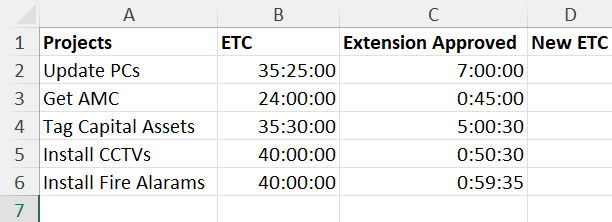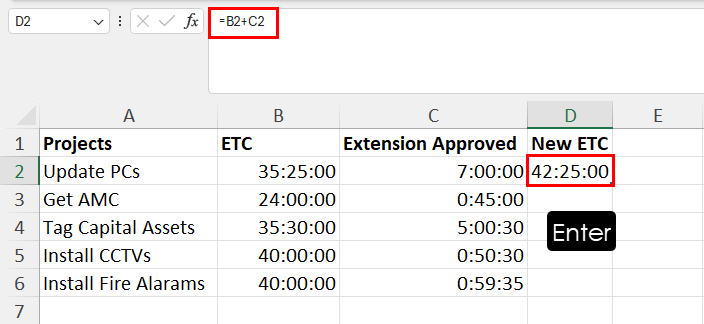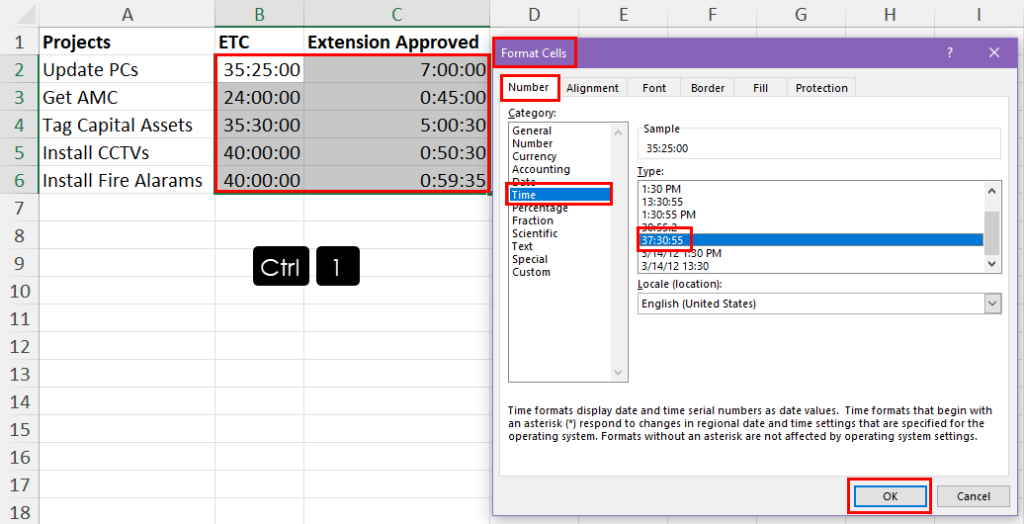4 Ways to Add Time in Microsoft Excel
Whether you are an experienced Excel user or just beginning to explore its capabilities, understanding how to add time in Excel is a critical skill that can streamline your data analysis and reporting activities.
In this comprehensive Excel tutorial, I will help you tackle complex time-related calculations in Excel, providing you with step-by-step instructions, practical tips, and insightful methods.
From basic time addition to handling more complex scenarios, this blog will give you the knowledge and confidence to seamlessly work with time-related datasets on Excel.
Recommended: 3 Ways to Sound an Alarm in Microsoft Excel
When might you need to add time in Excel?
Here are some common scenarios where you can apply the time addition technique in Excel:
- Project Management:
- Calculate the total duration of a project when there are multiple revisions to the duration.
- Track time spent on specific tasks or milestones.
- Schedule Work or Services:
- Determine total work time.
- Adding time can also help you calculate overtime.
- Reroute transportation or other services when delays occur.
- Event Planning:
- Calculate the duration of a large event by adding up the duration of its sub-events.
- Schedule and coordinate event schedules.
- Employee Time Tracking:
- Add work time for payroll processing.
- Analyze employee attendance patterns.
- Fitness and Health Tracking:
- Record your workouts.
- Monitor your sleep patterns or meditation sessions.
- Travel Planning:
- Calculate flight or journey times.
- Coordinate layovers or travel itineraries.
- Manufacturing and Production:
- Monitor production cycle times.
- Calculate machining or assembly durations.
- Education Schedules:
- Create course and study schedules
- Analyze time spent on different subjects
Add time in Excel using addition operators
Addition operators are the basic way to add time to durations or times of day in Excel.
However, the format in which you enter the values is critical to obtaining accurate results. You must apply a custom cell format to correctly express time values in Excel cells. Otherwise, you may get incorrect results. Although you can manually correct some incorrect time calculations, it is indeed challenging to do the same for large data sets.

Suppose you have a data set similar to the table above. You need to update the duration of the following items: Column D.

Go to the first cell in Excel where you want to calculate the sum of the time and duration. Enter the following formula into the cell:
=B2+C2Hit Enter to get the updated duration.

Now, use the Fill Handle of the first cell and drag it down the column to get the new time durations for the rest of the cells.
If the duration value entered is not in the correct format, you will not get the results shown above. Therefore, you must convert the input data before performing the above calculations.

Highlight all the duration values in the worksheet. Press Ctrl + 1 to bring up the Format Cells dialog.
In the Format Cells dialog, go to the Number tab and click on the Time category. In the Type list on the right, select the number code 37:30:55. Click OK to apply the time format.
Recommended: How to drive traffic to your Weebly website
Add time in Excel using the SUM function
This AND function is suitable when you need to add the duration of subtasks to get the total duration of a project.

Go to the cell where you want to sum a large number of time entries in hours:minutes:seconds format. Copy and paste the following formula into the cell, Then click Enter:
=SUM(B2:B6)You should customize the above content The and formulas depend on the data set you are working with. If the duration entered is not in the appropriate range Format of time values, use the “Format Cells” dialog box to reformat time entries.
Adding time in Excel using the TIME function
The TIME function in Excel is a useful tool for manipulating and processing time values. It allows you to add time to a specific hour by specifying , minutes, and seconds parts to create a time entry.
The syntax of the TIME function is very simple: =TIME(hours, minutes, seconds).
For example, to represent 3:30 p.m., you can use =time(15,30,0), provided that the cell format is hour:minute AM/PM .
This feature is especially handy when dealing with time-based calculations or combining durations with other functions to perform complex operations.
You can use the Time function to create data entry forms where employees can It updates the additional hours, minutes, and seconds for projects and tasks to get the new project duration for accurate billing. Here you can add hours, minutes, and seconds to the existing time duration. This method is more flexible than the ones explained so far because you do not need to apply any custom cell number formats. The Time function will automatically express the resulting duration as Hours:Minutes:Seconds strong> format.

Suppose you already have or want to create an Excel worksheet that will contain one column for recording the existing duration of the project or subproject. Then, there will be three columns for recording additional hours, minutes, and seconds used by the project or subproject. Finally, there will be another column for To record the total duration or completion time of the update.

In the first cell of the Total Duration column, enter the following formula and click Enter Easily add time in Excel:
=B2+TIME(C2,D2,E2)Please change according to your own Excel worksheet Cell reference.

To apply the same formula to the rest of the cells in the column, simply move the fill handle along Drag the column down until there is a reference cell value in the adjacent column.

Now, as you continue to enter values Hours< /strong>, Min, and Second columns, Excel will automatically add the values and fill the results into the cells you selected.
Recommendation: 3 Ways to Set Up Email Reminders in Microsoft Excel
Use the TIME function to add time to the AM/PM format
Suppose you are viewing a bus service schedule in an Excel worksheet. Your goal is to accurately monitor the delays in service start times on different bus routes. Condition.

In this case, your main task is to add hours, minutes, or seconds to the original start time. These times are usually in AM/PM format. This allows you to accurately track delayed service times and manage your bus schedule efficiently.
You can customize the worksheet based on the example above to have three different The columns are the Start Time for AM/PM time entries, the Delay BY column for hours, minutes, or seconds, and the New Start Time strong> The column in which you will perform the calculation.

Now, highlight the new start time column and enter the following formula:
=TEXT(B2 + TIME(0,C2,0),"h:mm AM/PM")</ code>Type enter to get the calculated time value.

Drag the fill handle down the column. to copy and paste the same formula for all bus routes.
Don’t forget to customize the cell references in the above formula based on your own data set. The current formula only adds minutes to the AM/PM time format.
If you need to add hours, use the following formula:

=TEXT(B2 + TIME(C2,0,0),"h:mm AM/PM")Or, you may need to add seconds, so use the following Formula:

=TEXT(B2 + TIME(0,0,C2 ),"h:mm:ss AM/PM")Conclusion
These are The simplest and easy to remember ways to add time in Excel. Please try the above methods and if you like them, please leave a comment below. Also, if you know of a better method than the ones I mentioned in this article, please leave a comment below. Mentioned in your valuable comments.
